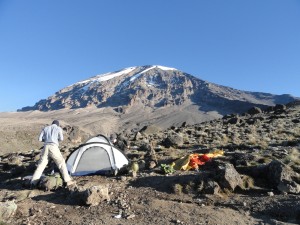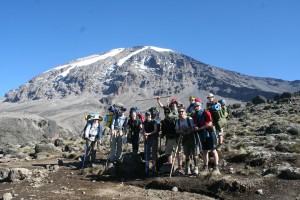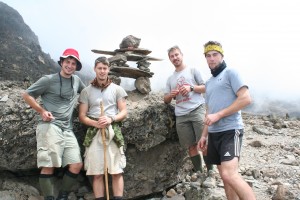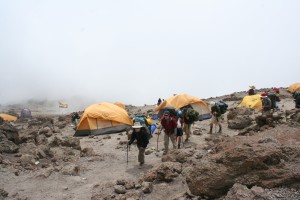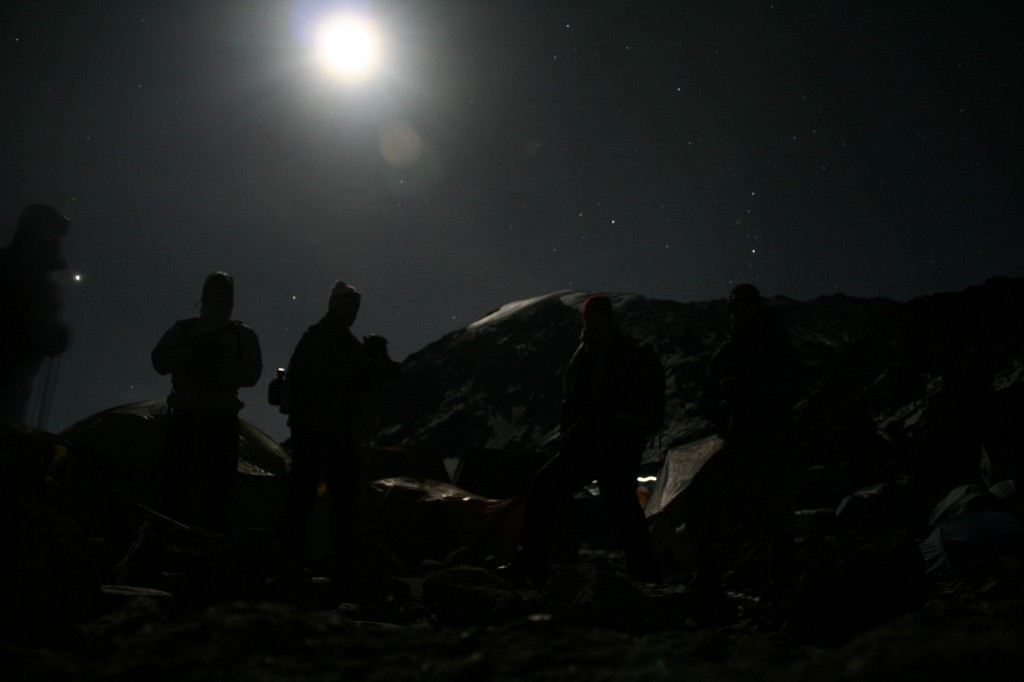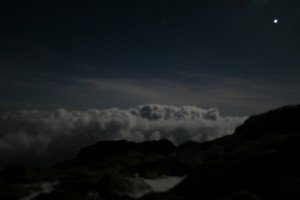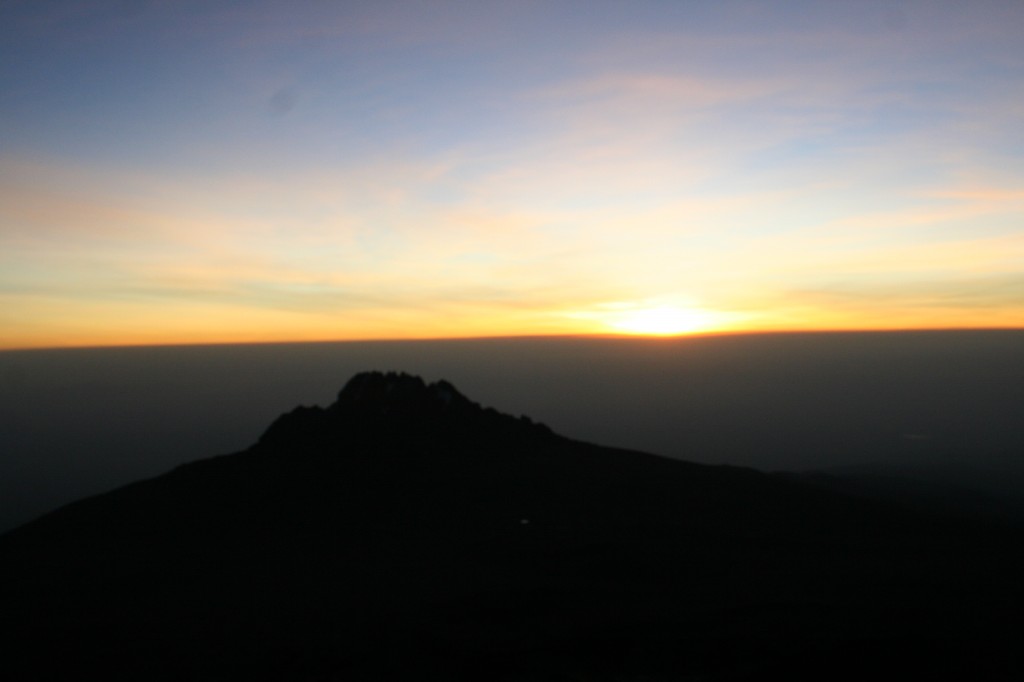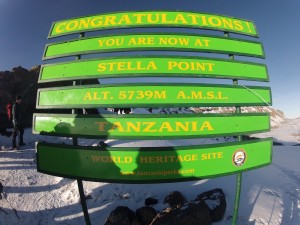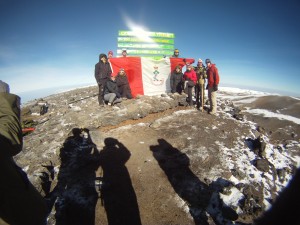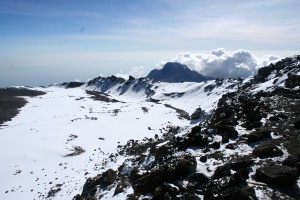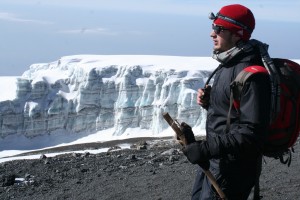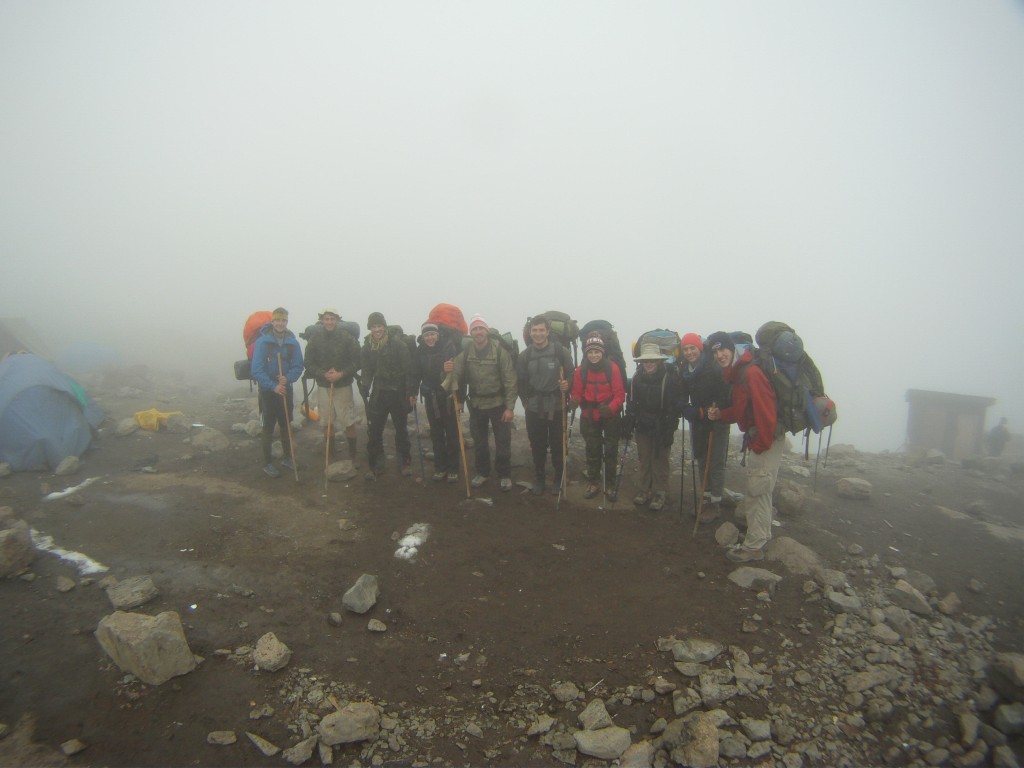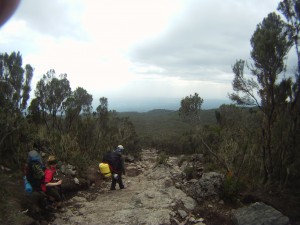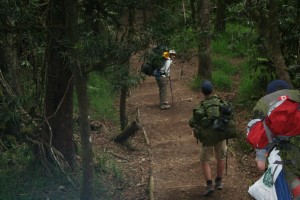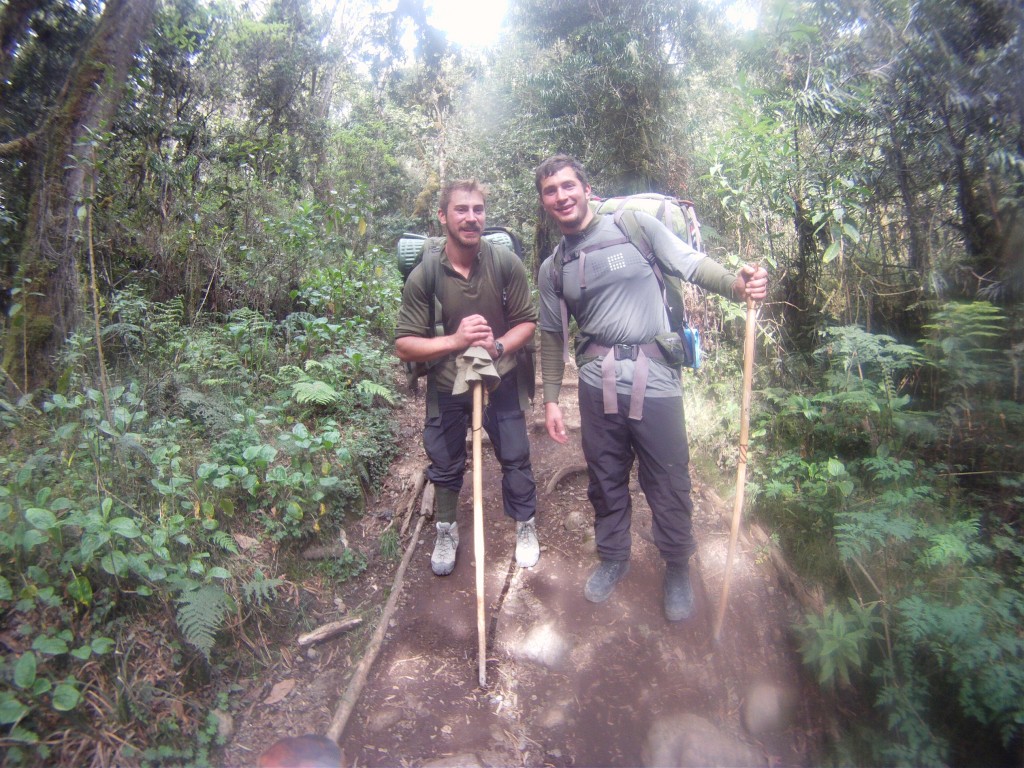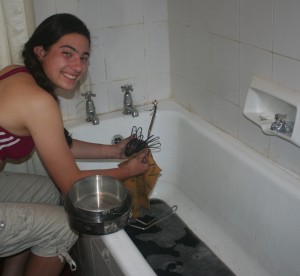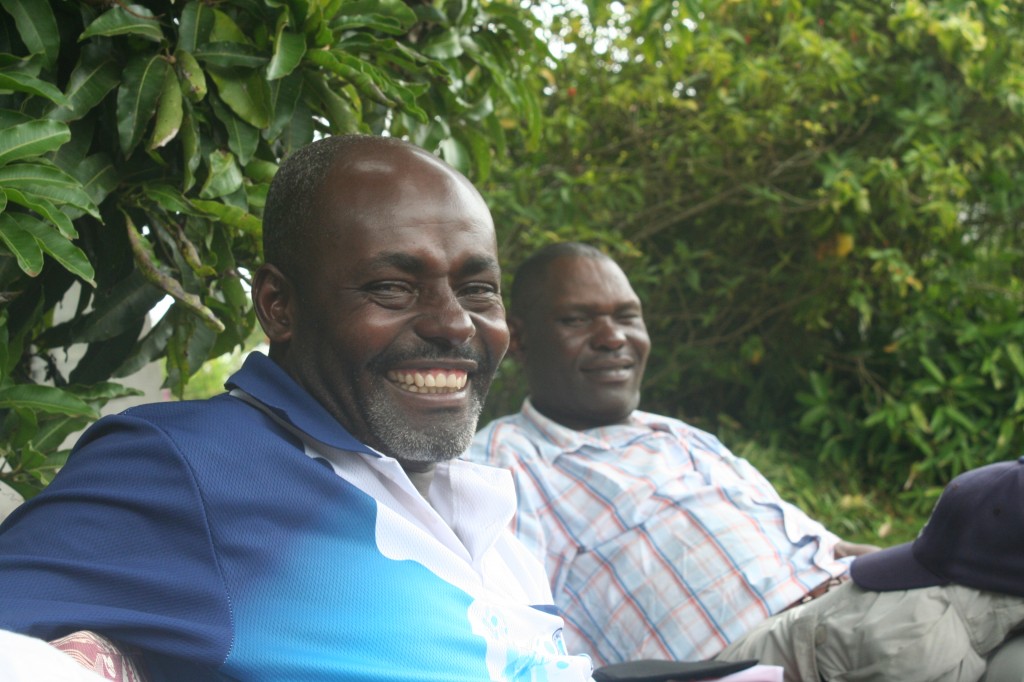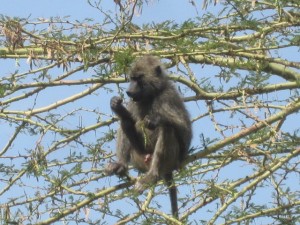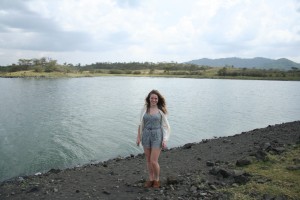
The following journal entries are apart of a series which will offer day-to-day accounts of the RMCC Expedition Club’s recent 2011/12 Kilimanjaro Expedition to East Africa. Click here to read the full expedition article.
Day Six 04 January 2012
24992 OCdt (IV) Eric Robb, Deputy Expedition Leader
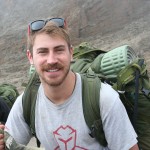 We woke up from an incredibly cold sleep. The roof of our tent was covered in frost from our breath throughout the night. As I pulled my toque over the bottom of my ears I coughed and weezed. The lack of oxygen was ever apparent now that we were getting so high. As I woke the rest of the crew, I couldn’t help but search for the tinge of the soon to be sun as it began to slowly rise far off to the east. The crew got up, the girls began to man the stove as usual, and kit was slowly put away. Just from walking around our small campsite I was completely out of breath. We all gave our ration packs to the girls to heat up, as it would be our only hot meal of the day. Finally the sun had burst into full over the neighboring mountain peak, and the ground began to steam as the frost slowly lifted into the air. We packed our bags up for the day and ate our breakfast, discussing what the day would be like, and knowing that if we made good time we could be starting the summit that evening.
We woke up from an incredibly cold sleep. The roof of our tent was covered in frost from our breath throughout the night. As I pulled my toque over the bottom of my ears I coughed and weezed. The lack of oxygen was ever apparent now that we were getting so high. As I woke the rest of the crew, I couldn’t help but search for the tinge of the soon to be sun as it began to slowly rise far off to the east. The crew got up, the girls began to man the stove as usual, and kit was slowly put away. Just from walking around our small campsite I was completely out of breath. We all gave our ration packs to the girls to heat up, as it would be our only hot meal of the day. Finally the sun had burst into full over the neighboring mountain peak, and the ground began to steam as the frost slowly lifted into the air. We packed our bags up for the day and ate our breakfast, discussing what the day would be like, and knowing that if we made good time we could be starting the summit that evening.
Stepping off from the site was always a good feeling. Walking by other climbers on the path gave us great satisfaction due to the looks that were given to us. All ten of us with bags the size of totem poles, and a guide in the front and the back was quite the spectacle compared to the groups of three or four, with at least 15 porters and guides scattered around the group.
The landscape had changed from day 3 to day 4 from small vegetation and trees to a barren land of house-sized boulders and scree. The incline we had begun to tackle was nothing like the previous day when we were scaling the ‘breakfast wall’, however it seemed never-ending. At each interval that we had thought we reached the top, another ridge appeared, kilometers away. The fact that the peak of the mountain looked down on us from kilometers above made it easier.
The packs were still around 80lbs at this point of the climb. We were moving at an incredibly slow pace, stopping at 30 min intervals to catch our breath and rest our bodies. I remember seeing small inukshuk’s along the way on top of some of the boulders, which inspired us to build our own. After about three hours of hiking, we made it to what seemed to be the top of the last hill. We had a rest and I cut up the remainder of the sausage that I had bought before the hike (whether it had gone bad after 4 days is still up for debate). A couple of us went to work to build the biggest Inukshuk that we could at the top of the ridge and leave our mark of Canadian heritage. After completion we marked it with a Canada flag, and were on our way.
Looking out over the next valley was a relief as we could see the summit camp in the distance. It didn’t look so far, however moving slowly at around 4500 asl would still prove to be a challenge. Morale was high as we continued on our way. We were memorizing the Swahili Greeting which you would sing to the porters and they would sing back. As we began to make our way across the valley, we suddenly became completely immersed in the clouds. It was one of the most sublime feelings, not being able to see 10 m in front of you, surrounded by slight moisture, completely enveloped in the whiteness.
After another 2 hours, we made it to the base of another large wall. Our guide told us it would take around an hour to hike, even though it looked no higher than a hundred meters or so. The rock color had completely changed from black volcanic rock and boulders, to lighter brown rock and scree. As we made our way up to the top of the hill, we could start to see other climbers’ tents in the different area’s of the summit camp. Continuing through the different camps, I couldn’t help but notice the smell. There were ‘toilet houses’ set up in 4 or 5 different locations that were essentially holes in the floor on the edge of either cliff, with the human waste in abundance at the base. The smell was less intense as we reached the upper part of the camp where climbers stepped off in the morning. Again, people were looking at us as if we were maniacs with our bags, and Alex and I were still in shorts and t-shirts despite the cold weather. Most of the other climbers had either just come down from the summit, or like us, were gearing up for the big climb in the morning.
The weather was cold, but the sun was out. After setting up our tent, we laid down, completely exhausted, as the altitude had really began to take its effect. Every breath was an effort; we were increasingly light headed, and deprived of every bit of energy and motivation to move. Despite this, Alex, Nick and I decided to explore the camp a bit, and get our meals ready for dinner. There were many climbers from all over the world who had seen us come in and were wondering what the hell we were doing. The general consensus was they had all wished they had taken the challenge and carried everything up to the summit themselves as well. I felt proud to tell other climbers what we were doing, and I felt even more proud to brand our efforts as Canadian.
After 4 days on rations, I was eager to try something new. Talking with some other porters, I traded my ration pack for a small portion of what the local guides and porters were eating. It consisted of a starchy potato-like substance, and a red vegetable and meat sauce that had a serious kick of spice to it. The porters gladly cut up the rations bread and scoffed down an omelet with salsa with great content. After dinner we laid down for a bit, and then it began. In a flash of lightning and thunder, the snow, hail, and sleet began to invade the camp relentlessly. I couldn’t believe the volume of snow that was coming down from the sky. In ten minutes there was a few centimetres of hail and snow on the ground. Anthony and I discussed the practicality of starting our ascent to the summit that evening with our guide, and he gave us the go ahead. Alex and I stood outside and recorded a video log in the storm, embracing the hail and snow. What a place to be for your Christmas break, on the equator in Africa in a snow storm!
We got our day bags ready for that evening, put on all of our warmest clothes, and laid down. We would be summiting in less than 3 hours. Although some of the group was afflicted with mild mountain sicknes, the anticipation was growing, the moral was high, and we were ready for the top.
Day Seven 05 January 2012
25881 OCdt (III) Anthony Matlock, Expedition Leader
 Summit Day began at 2300 the night prior at Barafu Camp. This bivouac is a maze of tents teetering between two cliffs of jagged rocks. The weather is cold and ill-tempered, and when it is not hailing, Kibo, the summit of Kilimanjaro, stands far above. At night, the altitude, stench of the latrines, and bursts of Swahili pierced by spasms of wind-battered tents disrupt anxious sleep. The three hours rest before our final ascent was especially unsettled.
Summit Day began at 2300 the night prior at Barafu Camp. This bivouac is a maze of tents teetering between two cliffs of jagged rocks. The weather is cold and ill-tempered, and when it is not hailing, Kibo, the summit of Kilimanjaro, stands far above. At night, the altitude, stench of the latrines, and bursts of Swahili pierced by spasms of wind-battered tents disrupt anxious sleep. The three hours rest before our final ascent was especially unsettled.
At 2300 the Expedition Group awoke, stomached chocolate and granola, and loaded special daybags with water. My pack carried the satellite phone and the RMC flag raised one year ago atop South America’s highest peak, Mt. Aconcagua. Just before setting off with our head guide, Charles, my stomach, immune to disease thus far – sickened. I dealt with the bad luck behind some rocks, rehydrated, and rejoined the team. By midnight we were good to go and set off into the darkness.
Summit Day on Aconcagua had been in a snowstorm across an icescape. The steep, zig-zag slopes of Kilimanjaro are snowless, and so the darkness, save the moonlight interrupted by monolithic outcrops, is total. One step became another in our order of march as each hour of the night led to frozen camelbacks and exhaustion. Walking into darkness and thinner air after four days of hard rucking and rations becomes melodic: the sound of right, left, your pole, and the scree underfoot. No one was immune to heavy eyelids, and the march upwards, well into its multiple hours, entered into the hardest psychological and physical test many of the expedition members had ever faced.
What I recall most are the headlamps, and more specifically, their psychological impact. Tourist-oriented climbers had a consistent proclivity for reducing the team’s night-vision with blinding white light; however, aside from this, looking up at Kibo was measured by a thin string of wavering light. This illumination dissipated in intensity until the next ridgeline melded seamlessly with the night sky. Those lights which were especially dim and too far to realize movement joined the stars, and each ridgeline yielded to another string of lights seemingly five times longer. Our immediate objective, Stella Point, the edge of Kilimanjaro’s volcanic crater became an ever yearned goal in this dream-like trial to the top of Africa. And still, after hours of climbing, the top of Kibo seemed no closer than it had at Barafu.
Sunrise meant progress. By 0600 the horizon split into an intense orange and the ground beneath our feet gained colour. Looking over my shoulder hardened my resolve: the sun breathed new day onto vast swathes of Tanzanian bush and Kilimanjaro’s sister peak, Mt. Meru. This motivational beauty dampened the night’s hardship.
And then we arrived at Stella Point, beneath the final tracks of the mountain’s retreating snow. The crater below the Point was much larger than expected, and the glaciers lining its wa lls were the size of high-rises. While sweet, Stella was not the objective, and so the expedition team set off once more into thin air along the snowy track for a two-hour march. During this interval, the team was treated by friendly congratulations from an ex-RMC cadet returning from Uhuru Peak, Kilimanjaro’s highest point.
The team spotted the green-tinted sign from a distance, and during the approach mission success washed over us. Upon arrival, we raised the RMCC flag, and took photos with the Commander-in-Chief’s and the Expedition Club’s crests. Immediately following, the team placed calls to family with the satellite phone, and we assembled for departure.
If going up was hard, going down was physically abusive. The team negotiated the slippery scree and hidden rocks in a rapid descent free-for-all. However, maintaining the military order we had demonstrated thus far, we returned together to Barafu camp at 1130 riding a second-wind: the summit, scheduled for day six, had been accomplished a day early despite our heavy loads and initial set-backs.
At this point in time, another unique potential feat presented itself. Speaking with my counterpart and head guide, Charles, an itinerary change would allow the group to leave the mountain entirely and return to the base camp for proper food, sleep and maximization of our time in Tanzania. This would mean the mission had been accomplished in five days instead of the intended seven. The original itinerary would see groups slowly descend via an exit route through a series of camps. The only caveat to this new option would be reaching a distant rainforest camp no later than 1600, so base camp transportation in Moshi could be feasibly arranged. For tourist-oriented groups, this meant a full day’s hike, for us: 4 hours.
Weighing the pros and cons with the Expedition Group, we made the decision to go for it with safety as the number one priority. By 1300 our camp was packed, rations eaten, and rucks fastened. We departed Barafu in its characteristic wind-swept and rainy fashion.
Our rapid descent over the next two hours was characterized by the transition of sub-Arctic terrain to low-level bush as we dashed deeper into the clouds. As blisters are the most common enemy on mountains next to altitude sickness, we had our first foot casualty. The most interesting part of this scenario was our interaction and cooperation with a second chain of command, or “friendly force” — the mountain guides. Charles and his team of four guides, acclimatized to our “hardway” mandate, mirrored our leadership structure. With myself in behind with a slower-moving group and Deputy Expedition Leader, 24992 OCdt Eric Robb, ahead with a faster group closing in on the lower camps, the guides split themselves accordingly – Charles with my group, and his 2 I/C, Joffery, with Robb’s.
The rear group arrived at the first woodland camp by 1430 and linked up with the rest of the team. With Charles’s permission, we continued onto the rainforest camp with a traditional time estimate of three hours. As half an hour remained in our own original objective, we would obviously be on borrowed time. With OCdt Robb’s group carving a path to the rainforest camp, and my own group moving at walking pace, we maintained contact with runners.
My group arrived at the rainforest camp by 1630. As OCdt Robb’s team had come and gone before our objective timing, Charles placed the call for base camp transport. Ahead of my group was another three hours through the rainforest to the park gate.
As the sun lowered, and our guides’ notorious time-estimates led to uncertainty about the distance to the park gate, I raced ahead to confirm transport, and joined OCdt Robb’s group just as the sun was setting. With darkness increasing, OCdt Robb and I ran ahead down curving paths which yielded to open cow pastures and water-logged routes. The endless trek, burning knees, and sore backs were all too reminiscent of our upward hike thousands of metres above less than a day ago.
Once we arrived at the park gate, and confirmed our base camp truck was waiting, we dropped our rucks and fought our second battle: securing a Land Rover from an African government checkpoint at night. Passed from a fixer to a soldier and to the Rover’s driver, in thirty minutes we were bombing back up the route, and successfully collected the remainder of the team. By 2000 the Expedition Group was reunited on board our base camp transport. By 2200 the team had returned to base, and enjoyed a meal, hot shower, and well-deserved sleep at safe altitude.
Over the past five days we had climbed Kilimanjaro via the hardest route in the absolute shortest time possible with an average of 40 kilos each. We had summitted and returned to base in the same day. Charles, over his 15 years of guiding experience, said he had never seen this type of expedition before. Evenmore, we executed the mountain climb in line with our military training and built upon our risk management and reactionary leadership skills. While it was a Seven Summit accomplishment, it was more so one of the best officer-training experiences we have ever had.
Day Seven 06 January 2012
26173 OCdt (II) Emily Morgan
The second I was aware of being awake, the pain hit. Any movement made it very apparent that we had just spent the previous day summiting a mountain, and then rapidly descending it. It took quite a lot of mental strength to make it out of bed and begin warming up our muscles.
We had all lost some weight, and we began the recovery process with a large breakfast accompanied with some excellent African tea. We met our guides and their porters at 11 for a drink, and to thank them. We asked them to write down the Tanzanian song they had been signing the whole way up the mountain, and that we had been adding our own ridiculous verses to.
The girls spent the rest of the day cleaning the equipment and figuring out how to do laundry in the bathtub. As soon as we added our mountain clothes to the clean, soapy water, it turned brown almost instantly. It was a challenge, but we managed to get our clothes to a reasonably clean standard.
The cooking pots were next, which had spent the previous five days on a kerosene fire and were black as a result. The water turned a similar shade, and our hands took a few days to return to normal. We had a great afternoon airing out kit, and cleaning, and generally relaxing. It was nice just to stay in one place for a bit, and to reminisce about the highlights of the climb.
We were joined at dinner by a group of Norwegian girls who we had succeeded in annoying thoroughly on the final night ascent by singing at the top of our lungs “We’ll be coming around the mountain when she comes.”
It was a very pleasant, relaxing day which everyone thoroughly enjoyed. We avoided any kind of downhill slope as our leg muscles couldn’t take it, and when the hotel staff saw us moving about, wincing, they would say with bemused expressions: “pole pole!” which was the Swahili word for slowly. We found out the hard way after a three hour dinner in which we had been sitting the whole time the importance of staying active so our muscles wouldn’t become too stiff. We all rose from the table to immediately sit back down, wincing in pain.
All in all it was a very pleasant change of pace compared with the previous days, and we had entertained ourselves to no end with the laundry and pot cleaning episode. We spent the evening in the hotel bar talking with the other guests who had just finished climbing as well, and swapped entertaining stories about our adventures.
Day Eight 07 January 2012
25739 NCdt (III) Brittany Brown
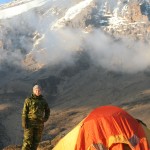 After our second painful wakeup at the scenic Marangu Hotel, the mountain was barely visible but the imposing silent screams of our recovering limbs reminded us how close the expedition still was to our hearts and how not so long ago we had all found a piece of ourselves in summiting Kilimanjaro. The meeting was set for 0800 after breakfast as we set off in a land rover and jungle van for a safari through the Arusha National Park. It was a typically bumpy two hour drive through Arusha and as always we witnessed all sorts of behaviours and local habits, some of which seemed strange and others incomparable to our Canadian customs. The sight of parents accompanied by their helmetless infant on speeding motorcycles or buses passing other cars or passing large trucks in busy traffic on single lane dirt roads was not unusual.
After our second painful wakeup at the scenic Marangu Hotel, the mountain was barely visible but the imposing silent screams of our recovering limbs reminded us how close the expedition still was to our hearts and how not so long ago we had all found a piece of ourselves in summiting Kilimanjaro. The meeting was set for 0800 after breakfast as we set off in a land rover and jungle van for a safari through the Arusha National Park. It was a typically bumpy two hour drive through Arusha and as always we witnessed all sorts of behaviours and local habits, some of which seemed strange and others incomparable to our Canadian customs. The sight of parents accompanied by their helmetless infant on speeding motorcycles or buses passing other cars or passing large trucks in busy traffic on single lane dirt roads was not unusual.
As the convoy pulled into the Arusha National Park entrance to cover entrance fees we took a quick glance at informative posters on fauna and flora typical to the area as well as a inaccurately sized park model where we joked about mammoth looking elephants seemingly scaling the mountain. As we took off into the park ‘Christmas,’ our driver, drove us straight into what is known as ‘little Serengeti’ where to our great surprise we immediately saw a couple of ‘dancing’ giraffes, a family of warthogs and a large herd of zebras. As we all stood under the raised roof of the land rover and safari van, we observed the wildlife through binoculars as our drivers pointed out a few interesting facts and explained the observed behaviour.
Following this initial encounter we set off in what quickly turned into rapidly changing scenery and landscape as we drove up towards the crater rim to observe from above. The wide range of birds and butterflies at the small museum was impressive as we opened unlocked drawers leading us to a wide range of preserved specimen which we could touch and closely examine, something you would rarely find in Canada.
As the safari continued we drove up and through the new and clearer landscape to a lunch point overlooking the lakes. It was nice to have everything from transportation to lunch boxes arranged for us after what had been a demanding week in the mountain. We enjoyed lunch in the company of an RMC graduate we had met at Marangu Hotel and also crossed paths with on summit day. Although it seemed we had been attached at the hip, this was the last moment shared in Africa. The view was breathtaking and we set off for the lakes where we saw more giraffes and warthogs on the way. We took another break at the lake and observed the flock of flamingos and large herd of giraffes across the small body of water.
The safari carried on into a laughing fest as we watched baboons in amusement. They seemed undisturbed by our presence and carried on in feeding off a lakeside tree only meters away from our vehicle. There were a few babies but it was only when two larger baboons feuded and took off in our direction that we realized the sheer power and unpredictability of the monkeys. Their roars resonated as we watched then chase each other up the trail ahead. Many considered this to be their favourite part of the Safari. As the tour concluded we were able to get a good glance at waterbucks, zebra, warthogs and buffalo in front of the scenic backdrop of the imposing dormant volcano.
After a long day in the wild we returned to Marangu Hotel and enjoyed a final supper with two of our members returning to Canada the next day.


